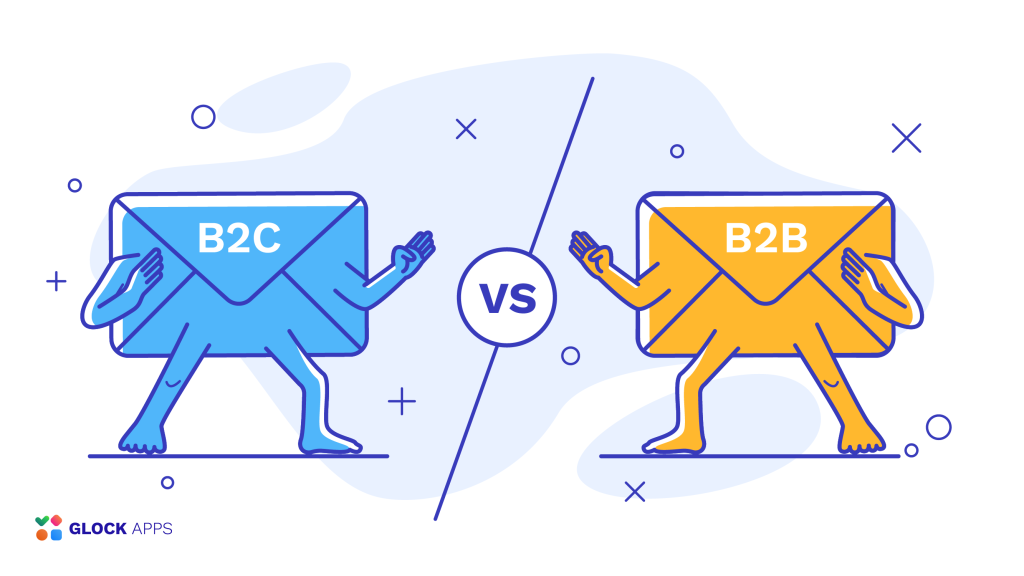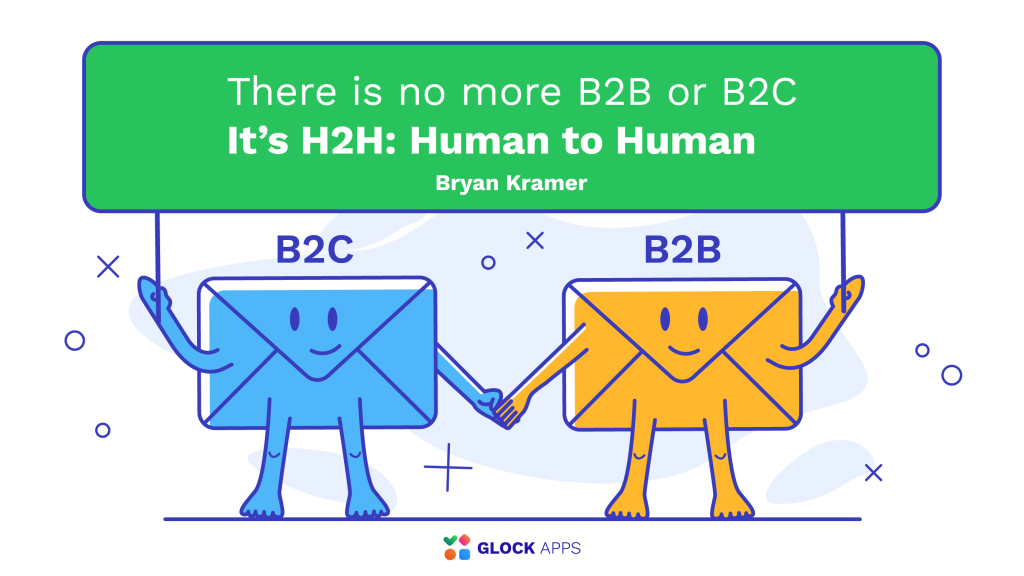B2B and B2C Email Marketing Strategies – Understanding the Differences

Estimated reading time: 8 minutes
What is the difference between B2B and B2C email marketing?
Email marketing continues to thrive in the digital sphere and stands as a fundamental tool for businesses aiming to connect, engage, and convert their target audience. However, the strategies used in this sphere are as diverse as the audiences they serve.
Business-to-business (B2B) and business-to-consumer (B2C) email marketing are the two most common models of operation in e-commerce and sales in general, but they are tailored for different purposes and require various skills and resources. Despite the similarity of the names, the differences are significant.
On the surface, it seems like one would be more logic-driven while the other appeals to emotions. However, as you will soon learn, this is not always true. Here are the main differences between B2B and B2C email marketing for your campaign success.
B2B vs B2C Email Marketing Motivation
In the last Content Marketing Institute research, three out of four B2B marketers use newsletters and other email tools to distribute their content, which centers around solving business challenges, nurturing relationships, and driving long-term growth, while B2C focuses on emotional connections, immediate sales, and customer retention. Understanding these motivation specifics is crucial for crafting effective email marketing campaigns tailored to the respective target audiences.
B2B motivation lies in showcasing expertise and offering valuable solutions to improve efficiency, productivity, or profitability. The focus is guiding leads through the sales funnel by providing relevant information at each stage, motivating prospects toward conversions, and fostering ongoing relationships.
B2C email marketing is often motivated by creating emotional connections with individual consumers. The content focuses on storytelling, evoking emotions, and creating a sense of brand affinity and credibility. The motivation here lies in eliciting positive emotions that prompt consumers to engage or make a purchase. Consumers are motivated by deals that offer value, savings, or exclusive access to products or services. The goal is to encourage immediate action and drive sales.
Strategy and Evaluation
B2B email marketing is ultimately driven by the goal of achieving a return on investment (ROI) and contributing to business growth. In other words, how will the expenses help the company meet its business goals? What anticipated returns can the company predict from this investment?
B2B marketers focus on demonstrating clear ROI methods and emphasize business-oriented benefits to fostering company growth. They concentrate on providing in-depth product insights, case studies, and financial justifications to validate investment decisions.
B2C is driven by personal customers’ needs rather than financial gains because people seek products or services that fulfill their desires, solve their problems, or enhance their lifestyles. Moreover, the perceived value in B2C transactions often extends beyond financial considerations. Brand loyalty and personal connection significantly influence purchase decisions here. That’s why experts suggest actively using compelling storytelling in your B2C email campaigns.
This variety of approaches requires individual strategies to lead your business to maximum effectiveness. Evaluation of the impact of B2B and B2C email campaigns significantly differs in focus and metrics and should have clear priorities customized to the unique objectives of each sector.
Learn more: How to Create an Email Marketing Strategy: Step-by-Step Guide
Buying Process
The B2C customers’ journey allows them to buy directly from emails, while the B2B buying process requires more trust and can take a much longer time for consideration. If we dive deeper, direct-to-consumer purchases typically involve smaller investments compared to purchases that are necessary for businesses.
In B2C marketing, usually, there’s a single end user or buyer, who often doesn’t encounter multiple layers of coordination or the need for external consultations before making a decision, which greatly simplifies the purchase process.However modern marketing specialists are increasingly claiming that it’s no longer a traditional confrontation of B2C versus B2B marketing. It’s rather a case of marketing with a long sales cycle vs a short sales cycle, because of the growing overlap between them. This gap decreases from the intermingling of strategies, blurring the lines between B2C and B2B approaches.
Audience Segmentation

B2B email marketing typically targets other businesses, focusing on decision-makers, departments, or specific job roles within companies. The emphasis here is on providing informative and solution-driven content to address the business needs of the recipient.
Conversely, B2C email marketing targets individual consumers. The segmentation might revolve around demographics, preferences, purchasing behavior, or lifecycle stages. These emails often aim to evoke emotions, engage, and prompt immediate action from the consumer. Focusing on higher conversion rates, creating compelling calls-to-action (CTAs) and persuasive content, and optimizing the user experience to drive instant purchases and conversions are very important here.It is also advisable not to neglect the email list segmentation in both strategies, because it leads to improved engagement and higher conversion rates. You can learn more in our blog post.
Email Content Creation
According to the Content Marketing Institute, most of the surveyed B2B marketers (74%) identified the value of the content they delivered as the primary factor contributing to the success of their campaign. The content strategy for B2B emails has to be much more selective and involves industry insights, case studies, whitepapers, or webinars that provide value and knowledge to assist in making informed decisions. The tone of voice remains professional, emphasizing the credibility and expertise of your company.
Here are a few examples of B2B email types commonly used in marketing:
- Product updates and announcements
- Educational content, informational blog posts
- Event invitations
- Lead nurturing campaigns
- Customer onboarding and training
- Renewal or upgrade reminders
- Survey and feedback requests
- Abandoned cart, inactive user reminders
- Holiday greetings
- Seasonal offers
Conversely, B2C emails lean towards storytelling, product showcases, discounts, promotions, hot offers, and incentives. These emails aim to captivate the consumer’s attention, evoke desire, and prompt them to take immediate action. It makes them more simple and flexible, giving the content team more freedom for creativity. The tone of voice in B2C emails is typically conversational, positive, friendly, and engaging.
Here are different types of B2C emails you can use in your campaigns:
- Promotional offers and sales
- New product launch announcements
- Personalized recommendations
- Welcome emails for new subscribers
- Abandoned cart reminder emails
- Customer loyalty program updates
- Seasonal campaigns
- Birthday or special occasion offers
- Educational content, informational blog posts
B2B vs B2C Email Content Strategy
| B2B | B2C | |
| Target Audience | Professionals, decision-makers, specific job roles | Individual consumers, diverse demographics, varying interests |
| Tone of voice | Professional, emphasizing the credibility and expertise of your company | Conversational, positive, friendly, and engaging |
| Content type | Industry insights, case studies, whitepapers, or webinars that provide value and knowledge | Storytelling, product showcases, discounts, promotions, hot offers, and incentives |
| Template | Well-organized, informative, and structured layout with a business-related focus | Simple and flexible, giving the content team more freedom for creativity |
| Subject Line | Clear and relevant | Creative and attention-grabbing |
| Personalized Sequences | Targeted emails, segmented campaigns | Dynamic content blocks, triggered emails, user-specific offers, lifecycle emails |
| Contact Information | Company details, professional titles, social media profiles (LinkedIn) | Customer support, social media links, direct contact options |
| CTA | Scheduling a consultation, downloading a whitepaper, exploring product information | Making purchases, exploring new collections, interacting with content |
| Engagement Goal | Business relationships, addressing pain points | Emotional connections, driving immediate actions |
| Customization Focus | Business needs, industry pain points, professional context | Individual preferences, past purchases, lifestyle relevance |
Conversion Goals in Email Marketing B2B vs B2C
How is B2B email marketing different from B2C in conversion objectives? Fundamentally. B2B campaigns often focus on lead generation, nurturing, and building long-term relationships. The aim is to guide prospects through the sales funnel, leading to business partnerships or contracts.
In contrast, B2C campaigns frequently aim for immediate sales, customer retention, or engagement. The goal is to prompt consumers to make purchases, interact with the brand, or participate in loyalty programs.
B2B and B2C Email Marketing Challenges
B2B marketers often struggle to pinpoint the most relevant contacts with the authority and need for their products or services. Identifying and reaching the right decision-makers or stakeholders within a business and tailoring messages that resonate with various industries, job roles, and company sizes for maintaining a personal touch is always a challenging process.
Individual consumers receive numerous emails daily, making it challenging for B2C marketers to capture attention and stand out in the competition for inboxes. With the rise of mobile device usage, optimizing B2C emails for various screen sizes and devices has become crucial. Designing responsive emails that look well on mobile also remains a frequent challenge. Data privacy has become essential, leading businesses to adopt strict practices. Both B2C and B2B email marketers face challenges in reaching inboxes due to protective measures by email providers and gateways, guarding against cyber threats like phishing and malware. While crucial for security, these measures make it harder for marketers to stand out in crowded inboxes.
Conclusion

But in any case, we must remember that no matter how different B2B and B2C email marketing are, they both ultimately revolve around human connections. Quoting renowned business strategist Bryan Kramer: «There is no more B2B or B2C. It’s, H2H: Human to Human».



